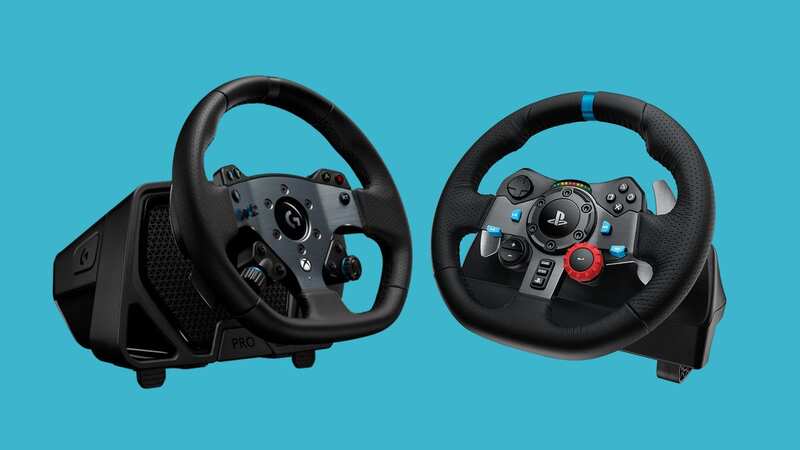Direct-drive vs belt-driven racing wheel technology explained – key differences

The difference between direct-drive and belt-driven racing wheels is pronounced, in terms of both price and immersion. Here are the key differences between the two technologies.
When it comes to sim racing, whether you're playing F1 23 or Forza Motorsport, there's a direct correlation between the level of immersion you can achieve and the level of enjoyment. Generally, the more you can immerse yourself as a racer, the more you'll be able to focus and enjoy driving as quickly as possible around a racetrack. And, if you want immersion, you'll want a dedicated racing wheel.
But with so many options from the likes of Logitech, Thrustmaster, and Fanatec, it can be hard to decide what you need, or how much to spend. Depending on your budget, your choice will ultimately come down to whether you want a direct-drive or a belt-driven racing wheel.
So, what's the difference between direct-drive vs belt-driven? Allow us to explain.
Direct drive vs belt-driven: what is the difference?
Most entry-level racing wheels, those typically priced under £300, use belt-driven racing wheel technology. While this technology makes the wheel more affordable, the force feedback, overall fidelity and feel through the wheel can often feel diluted. That's because belt-driven wheels generate force feedback through belts or gears that are connected to an electric motor.
 EA Sports FC – 10 new features we want to see in the FIFA successor
EA Sports FC – 10 new features we want to see in the FIFA successor
The motor generates force feedback from the data it's being fed from the racing game you're playing, which is then sent through a belt or gear, that then gets transmitted to the wheel itself. As there are so many components involved in the process, the fidelity of the force feedback is severely limited, as detail is lost at every stage.
 Most entry-level racing wheels, those typically priced under £300, use belt-driven racing wheel technology
Most entry-level racing wheels, those typically priced under £300, use belt-driven racing wheel technologyWith racing wheels that have direct-drive technology, the steering wheel is directly mounted to the motor shaft, and there's no belt or gear involved in the process to dilute the force feedback effects, allowing for more detailed and powerful force feedback, which significantly increases the feeling of immersion. A typical belt-driven racing wheel generates around 2.2Nm of torque whereas a direct-drive racing wheel can generate over ten times that amount.
Direct drive vs belt-driven: which is better?
In practice, this means that subtle feedback, like the slip of a tyre, a loss of traction or a slight change in road surface can be more easily felt through a direct-drive wheel, which wouldn't be the case with a belt-driven alternative. In Lehmann's terms, if a belt-driven wheel was a 720p DVD, a direct-drive wheel would be like a 4K Blu-ray. Direct-drive wheels are better than belt-driven wheels, there's no comparison.
 With racing wheels that have direct-drive technology, the steering wheel is directly mounted to the motor shaft, and there's no belt or gear involved in the process to dilute the force feedback effects
With racing wheels that have direct-drive technology, the steering wheel is directly mounted to the motor shaft, and there's no belt or gear involved in the process to dilute the force feedback effectsBut the extra immersion comes at a cost, with direct-drive wheels often significantly more expensive than belt-driven wheels. For example, the most popular belt-driven racing wheel on the market right now is the Logitech G29/G920, which can be picked up for around £200 / $200 / AU$374, and includes the wheel and a set of pedals. There's also the Thrustmaster T248, which is also priced at around £200 / $200 / AU$374.
One of the most affordable direct-drive options right now is the Fanatec CSL DD, which is priced at £349.95 / $349.95/ AU$517 for the 5Nm version, and £449.95 / $449.95/ AU$664 for the 8Nm version, but that is just the wheelbase itself, so for that price, you don't get a wheel or pedals.
The Logitech G Pro racing wheel is one of the most consumer-friendly direct-drive options, which includes the wheelbase, the wheel and a set of pedals for £999 / $999 / AU$1477, but you can spend much more than that, with one of the most premium direct-drive options, the Simucube 2 Ultimate (32Nm) coming in at around £3000 / $3000 / AU$5623.
If you're after a wheel for Formula 1 games specifically, we've put together a list of the best racing wheels for F1 23, including the best budget, direct-drive and premium options.
Read more similar news:
Comments:
comments powered by Disqus

































